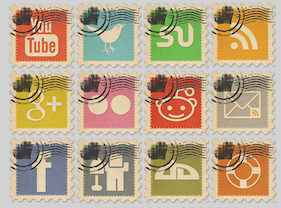From Elon Journal of Undergraduate Research in Communications VOL. 4 NO. 2Constantly Connected: The Impact of Social Media and the Advancement in Technology on the Study Abroad Experience
IN THIS ARTICLE
KEYWORDS
AbstractThis study examined the impact of the advancement in technology and convenience of social media on the study abroad experience. It tried to determine whether smartphones and their ability to remotely access the Internet on the go positively or negatively affect the study abroad experience. The results indicated that the advancement of technology has positively impacted the abroad experience because of the convenience it offers users in communicating and finding information while on the go. However, the study found that the pervasiveness of the social media negatively affected the study abroad experience; people often seem more interested in documenting an experience for the Internet instead of fully appreciating the moment while abroad. I. Introduction The increase in new media and communications has significantly impacted globalization in the recent decades. Traveling and communicating internationally are easier now than ever before. The popularization of smartphones and social media allows the world to be constantly and conveniently connected.
According to Guo-Ming Chen (2012), new media has brought human interaction and society to a highly interconnected and complex level. However, it challenges the very existence of intercultural communication in its traditional sense. It used to take a letter several weeks to cross the Atlantic Ocean. Today, it takes less than a second to relay a message via mobile device. International travel isn't so lonely anymore with continuous conversation and interaction with the world. Teenagers and young adults are pursuing their academic careers overseas through study abroad programs in various cities around the world. Sojourner is a term commonly used in study abroad literature to describe an individual who is temporarily studying and living in a foreign county, otherwise referred to as a "study abroader" (Twombly, Salisbury, Tumanut & Klute, 2012). Thousands of miles away from home, access to the Internet and social media remains in the sojourner's pocket due to international cellular data plans on smartphones. Within seconds, taking a tour through Vatican City can switch to an interactive online experience with friends and family back at home. This instant communication allows a transparent and comforting experience for both the senders and the receivers. Because of this connection, the distance while abroad appears less intimidating. Through access to new media, friends and families are able to live vicariously through these young sojourners and vice versa. Studying abroad is a valuable and enriching experience, but it can be easily lost due to the distraction of new media. According to Copeland and Hatcher (2007) this generation has never been more wired, yet so less connected. Zemmels (2012) states that traditional media research views young people as a special group in need of protection from media and especially their potentially negative influences. As early adopters of new digital technologies, young people tend to be at the forefront of new media interaction, thus shaping it through their practices. This paper tried to answer questions: What impact does the adoption of social media and smartphones has on the study abroad experience? Why do students abroad feel the need to be constantly connected? II. Literature ReviewThere has not been much academic research on the effect of modern technology and social media on the study abroad experience. Therefore, it is worthwhile to examine the study abroad phenomenon in relation to the recent advancement in digital technologies and the popularization of social media. The globalization of technology has enabled digital users to access and upload information immediately, thus resulting in a constant connectivity among users. The Study Abroad PhenomenonBecause this study looks at the impact of social media and new technologies on the study abroad experience, it is necessary to first understand why students study abroad. By providing students the opportunity to earn course credits in another country, study abroad programs have positioned themselves as institutional activities on college and university campuses across America (Twombly et al., 2013). Although prevalent today, the idea of earning an education in another country is far from new; students have been studying abroad for centuries. In colonial times, there were few colleges in America, thus fewer options for higher education. Additional training had to be completed through an apprenticeship or education abroad. In the 1800s, religious programs were created in order to send their students abroad as missionaries to achieve their higher education. Institutions soon understood the impact that students could make as enriched global citizens (Mistretta, 2008). According to Mistretta (2008), only white wealthy males were able to study abroad prior to the 20th century. The Rhodes Scholarships were established in 1903 to encourage international study for all students, no matter their economic status. The most intelligent students from around the world were invited to study at Oxford University in London, England. After World War II, Senator J. William Fulbright continued to promote international study and research in hopes of building ties between nations and preventing future hostility among nations. The Fulbright program provides scholarships for graduate students and scholars with a desire to study and conduct research abroad (Mistretta, 2008). By 2008, more than 90% of all colleges and universities in the United States offered study abroad programs. The number of U.S. students studying abroad continues to increase regardless of the fluctuating economy. Between the years of 2010-2011, 271,000 students studied abroad (Twombly et al., 2013). Study abroad is now a trend in the tourism market (Yu, 2008). However, there is a lack of diversity among those who are able to study abroad. The majority of the U.S. study abroad population is "white, female, young, single, financially comfortable, and without diversity." (Twombly et al., 2013, p. 37). The female to male ratio is 2:1 and this statistic has stayed consistent over time (Twombly et al., 2013). According to Twombly et al. (2013), students who have studied abroad are more globally aware and academically driven. "To continue to compete successfully in a global economy and to maintain our role as a world leader, the United States needs to ensure that its citizens develop a broad understanding of the world, proficiency in other languages, and knowledge of other cultures," said Bill Clinton (p. 23) in 2001. Those who study abroad value intercultural interaction as part of their college education. Students who express interest in improving their understanding of other cultures and countries are twice as likely to study abroad as those who do not. Improving one's foreign language skills, exposure to diversity, and cultural understanding are all motivations for students to study abroad (Twombly et al., 2013). In order to examine the effect of the study abroad experience, a case study was performed on eight former participants from Buffalo State College that spent a semester in Siena, Italy between the years of 1962 and 1991. Through in-person interviews, the study showed that there are varying effects of study abroad. While abroad, students are exposed to new learning and experiences, which can have life-changing effects on the individual. Furthermore, students learn more by becoming involved and engaging themselves in the culture around them. The stronger the involvement or effort, the more the student will learn; thus, the larger the effect will be (Mistretta, 2008). According to Twombly et al (2013), a number of positive outcomes result from participating in studying abroad. Research supports that studying abroad improves retention and academic performance. The experience broadens the students' horizons by helping them learn the language and immerse themselves in the culture. It deepens the student's openness to diversity and assists them in developing into adulthood. New Media and Digital TechnologiesYoung people are innovative leaders when it comes to new media interaction, Zemmels (2012) stated. Media formats have transformed into a mobile phenomenon, including personal computers, cellular phones, tablets, etc. International data plans and wireless mobile connectivity allow telephone and Internet access anywhere (Zemmels, 2012). Access to excellent mobile service is available all around the world. Cell phones with simple features, such as calling and texting, allow users to work and play on the Internet. Smartphones, such as iPhones, BlackBerrys and Androids, have enabled users to roam the world while staying in touch with anyone at almost any time. In 2009, sales of smartphones were up by 70% in North America (Levinson, 2012). According to Chen (2012), innovations in digital media continue to change the way we think, act and live. New media has taken communication to a higher interconnected and complex level. Mobile access allows communication to be readily available and convenient. The users are in control of what is viewed and shared. This freedom empowers the process of human communication (Chen, 2012). Users are free of the "the constraints of physical proximity and spatial immobility" (Buckingham, 2008, p. 147). By increasing both the amount and quality of interpersonal communications, these interconnected devices are able to make communication faster and easier (Adler et al., 2012). In relation to study abroad, Huesca (2013) believes that new communication technologies take time away from indulging in the local culture. Levinson believes that "humans are inherently multitasking organisms" and perceive new media to be an extension of our lives (p. 20). Smartphones satisfy the human need to have any information at any time or place. Levinson (2012) states: The fact that you can disseminate whatever information you please, to whatever portion of the world you like, from your smartphone, iPad, or any other mobile web-connecting device at hand, means that your access to the world, and its access to you is as much a part of you, as close at hand, as your hand itself" (p. 29)Continued on Next Page » Suggested Reading from Inquiries Journal
Inquiries Journal provides undergraduate and graduate students around the world a platform for the wide dissemination of academic work over a range of core disciplines. Representing the work of students from hundreds of institutions around the globe, Inquiries Journal's large database of academic articles is completely free. Learn more | Blog | Submit Latest in Business & Communications |




















